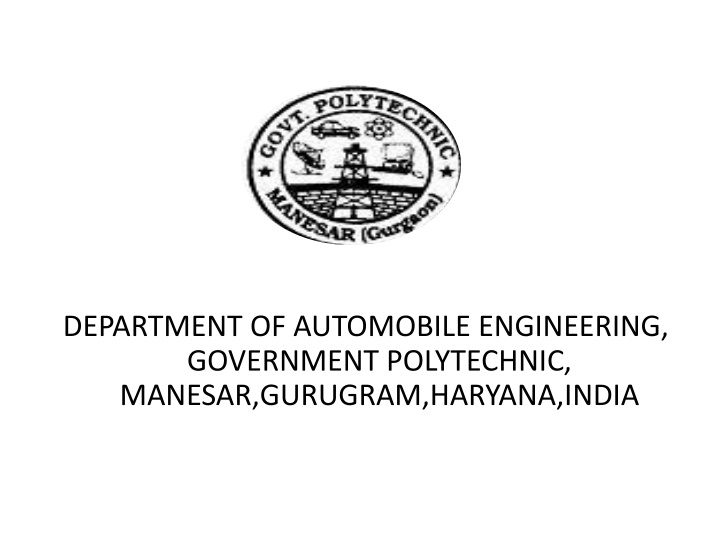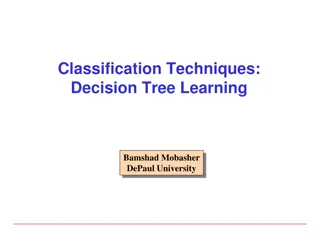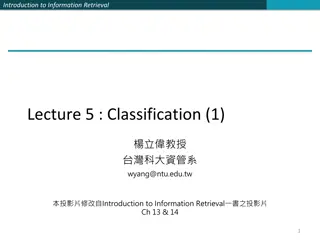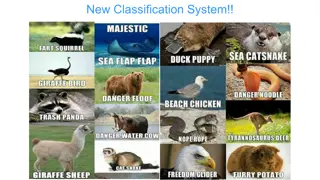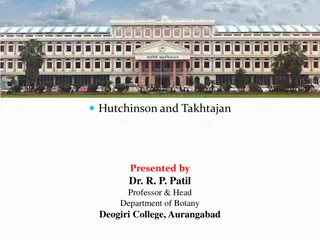Evolution and Classification of Tractors
The agricultural tractor, a vital mobile machine, has evolved over the years into different forms like two-wheel drive, four-wheel drive, and more. Learn about the history, design principles, and classifications of tractors based on their purpose, layout, and features.
Download Presentation

Please find below an Image/Link to download the presentation.
The content on the website is provided AS IS for your information and personal use only. It may not be sold, licensed, or shared on other websites without obtaining consent from the author.If you encounter any issues during the download, it is possible that the publisher has removed the file from their server.
You are allowed to download the files provided on this website for personal or commercial use, subject to the condition that they are used lawfully. All files are the property of their respective owners.
The content on the website is provided AS IS for your information and personal use only. It may not be sold, licensed, or shared on other websites without obtaining consent from the author.
E N D
Presentation Transcript
DEPARTMENT OF AUTOMOBILE ENGINEERING, GOVERNMENT POLYTECHNIC, MANESAR,GURUGRAM,HARYANA,INDIA
TRACTOR AND SPECIAL PURPOSE VEHICLES
INTRODUCTION OF TRACTOR The agricultural tractor is one of the class of mobile machines that involves the traction process. The word 'traction' and name 'tractor' come from the word to 'draw' or 'pull' so a tractor is basically a machine for pulling; other mobile machines such as locomotives are in the same class. Vehicles like road trucks and even motor cars, which are essentially vehicles for carrying loads, also involve the traction process. The tractor is also in the class of machines that involves operation under what are known as 'off- road' conditions. Others in this class include machines used in earth moving, mining and military work, also four-wheel drive motor vehicles for cross - country operation.
Development of tractor The tractor evolved in the second half of the 19th century and first half of the 20th into its present, conventional, two wheel drive form and four wheel drive variation. This form owes much to history but also the fact that it is an inherently logical arrangement. Designers followed early tractor designs that were simply replacements for horses or other draught animals. (ii) The layout takes advantage of the transfer of weight to the main driving wheels at the rear, as the drawbar pull on the tractor increases. (iii) The layout is inherently stable in the horizontal plane because the implement commonly being pulled behind the tractor tends to follow the latter and to pull it into straight line operation. (iv) Rear mounted implements offer a minimum of offset loading and moment in the horizontal plane; this contrasts with, for example side mounted implements.
TRACTOR CLASSIFICATION Two-wheel drive Four-wheel drive Front wheel assist Articulated tractors
TRACTORS Two wheel drive Front- wheel assist Four wheel drive (articulated) Tracked tractors
On the basis of purpose, wheeled tractor is classified into three groups: General purpose tractor: It is used for major farm operations; such as ploughing, harrowing, sowing, harvesting and transporting work. Such tractors have (i) low ground clearance (ii) increased engine power (iii) good adhesion and (iv) wide tyres. (b) Row crop tractor: It is used for crop cultivation. Such tractor is provided with replaceable driving wheels of different tread widths. It has high ground clearance to save damage of crops. Wide wheel track can be adjusted to suit inter row distance. (c) Special purpose tractor: It is used for definite jobs like cotton fields, marshy land, hillsides, garden etc. Special designs are there for special purpose tractor.
Main tractor assemblies (1) I. C. engine, (2) Clutch (3) Transmission gears (4) Differential unit (5) Final drive (6) Rear wheels (7) Front wheels (8) Steering mechanism (9) Hydraulic control and hitch system (10) Brakes (11) Power take-off unit (12) Tractor pulley and (13) Control panel.
Types of engine used Every tractor is fitted with an I. C. engine, the engine may be carburettor type or diesel type but nowadays almost all the tractors are diesel engine tractors.
SELECTION OF TRACTOR (1) Land holding: Under a single cropping pattern, it is normally recommended to consider 1 hp for every 1 hectares of land, In other words, one tractor of 20-25 hp is suitable for 20 hectares farm. (2) Cropping pattern: Generally less than 1.0 hectare/hp have been recommended where adequate irrigation facilities are available and more than one crop is taken. So a 30-35 hp tractor is suitable for 25 hectares farm. (3) Soil condition: A tractor with less wheel base, higher ground clearance and low overall weight may work successfully in lighter soil but it will not be able to give sufficient depth in black cotton soil. (4) Climatic condition: For very hot zone and desert area, air cooled engines are preferred over water-cooled engines. Similarly for higher altitude, air cooled engines are preferred because water is liable to be frozen at higher altitude. (5) Repairing facilities: It should be ensured that the tractor to be purchased has a dealer at near by place with all the technical skills for repair and maintenance of machine. (6) Running cost: Tractors with less specific fuel consumption should be preferred over others so that running cost may be less. (7) Initial cost and resale value: While keeping the resale value in mind, the initial cost should not AG ENGG 243 Lecture 9 2 be very high; otherwise higher amount of interest will have to be paid.
SOME TECHNICAL TERMS CONNECTED WITH TRACTORS Wheelbase: Wheel base is the horizontal distance between the front and rear wheels of a tractor, measured at the ground contact. Ground clearance: It is the height of the lowest point of die tractor from the ground surface, the tractor being loaded to its maximum permissible weight. Track: Track is the distance between the two wheels of the tractor on the same axle, measured at the point of ground contact. Turning space: It is the diameter of the smallest circle, described by the outermost point of the tractor, while moving at a speed, not exceeding 2 km/hr with the steering wheels in full lock. Cage wheel: It is a wheel or an attachment to a wheel with spaced cross bars for improving the traction of the tractor in a wet field. It is generally used in paddy fields.
Introduction Features of tyre Features of wheel Features wheel base/ wheel track Specification of wheel and tyre Tread design Differential lock
TRACTOR CHASSIS *INTRODUCTION *TRACTOR CHASSIS *HYDRAULIC SYSTEM *BRAKINK SYSTEM *SUSPENSION SYSTEM *MAINTAINANCE OF TRACTOR
TRACTOR CHASSIS A tractor is an engineering vehicle specifically designed to deliver at a high traction (or torque) at slow speeds, for the purposes of hauling a trailer or machinery used in agriculture or construction. Most commonly, the term is used to describe a farm vehicle that provides the power and traction to mechanize agricultural tasks, especially (and originally) tillage, but nowadays a great variety of tasks. Agricultural implements may be towed behind or mounted on the tractor, and the tractor may also provide a source of power if the implement is mechanised.
TRACTOR CHASSIS What is Tractor Chassis Definition: Chassis is called the base or frame of a tractor. Types of Tractor Chassis Frames Chassisless Tractor Tractor having Chassis Frame.
HYDRAULIC SYSTEM Principle of hydraulic drive system: Pascal's lawis the basis of hydraulic drive systems. As the pressure in the system is the same, the force that the fluid gives to the surroundings is therefore equal to pressure area. In such a way, a small piston feels a small force and a large piston feels a large force. The same principle applies for a hydraulic pump with a small swept volume that asks for a small torque, combined with a hydraulic motor with a large swept volume that gives a large torque. In such a way a transmission with a certain ratio can be built. Most hydraulic drive systems make use of hydraulic cylinders. Here the same principle is used a small torque can be transmitted into a large force.
BRAKING SYSTEM That's why brakes use hydraulics: a system of fluid-filled pipes that can multiply force and transmit it easily from one place to another. When you press on the brakepedal, your foot moves a lever that forces a piston into a long, narrow cylinder filled with hydraulic fluid.
MEACHINICAL BRAKE STSTEM brake is a mechanical device that inhibits motion by absorbing energy from a moving system. It is used for slowing or stopping a moving vehicle, wheel, axle, or to prevent its motion, most often accomplished by means of friction.
SUSPENSION SYSTEM Suspension is the system of tires, tire air, springs, shock absorbers and linkages that connects a vehicle to its wheels and allows relative motion between the two. The design of rear suspension of a tractor may be different. front and
MAINTENCE OF TRACTOR 1. FMP 211 Farm Power and Machinery (1+1) 2. MAINTENANCE OF TRACTOR 3. Study your owner s manual 4. The manufacturer has specific instructions for basic care of your tractor, and they have the expertise to give you the best advice on how to do it. This will tell you the intervals for routine maintenance, including chassis lubrication, engine, transmission, and hydraulic oil change, filter changes, and other maintenance items. 5. Obtain tools 6. Tractor maintenance requires numerous wrenches an other tools in larger sizes than for automobile maintenance, so plan to buy or borrow the tools you need.
7. Protect the tractor from the elements 8. Check fluids regularly 9. Check tire inflation 10.If tires run with excessively low tire pressure, tread wear increases dramatically. Adjust air pressure for the type of work planned for the day ahead. If road travel is expected, add a few pounds of pressure to each tire. If tillage is expected, reduce pressure by a few pounds. 11. Keep an eye on belts and hoses 12. Keep the brake linkages lubricated, and make sure the brakes are adjusted equally 13. Watch the gauges 14. Keep an eye on the temperature, oil pressure, and tachometer. The temperature gauge should be marked with a normal operating range, but any time the indicator says the temperature is over 220 F (104 C), the engine is running hot.
15. Check the filters regularly 16. Check the air filter often. Tractors are often operated in very dusty conditions, and in some cases, the filters must be cleaned daily or weekly. Clean the air filter with a shop vacuum or with compressed air, never by washing it. Replace the air filter when it cannot be cleaned satisfactorily, or if the filter is damaged. 17. Check the radiator screen 18. Tractors are often operated in conditions where debris may accumulate on the radiator, so they usually have a front screen or grill to prevent plant matter, insects, or pollen from clogging the radiant.
Feature of tyre Tyre should not skill or slip on the road surface. Tyre should be able to carry the vehicle load. Tyre should be balanced dynamically and as well as statically.
Feature of wheel The wheel strong enough to withstand the weight of the vehicle. Flexible to absorb the road shocks. Able to grip the road surface. Light and easily remarkable.
Feature of wheel base / wheel track Wheel base should be better flotation. Wheel base should be smoother ride on rough field. More stability on hillside and able to maintain traction. Easier implement hook up.
Specifications of wheel Wheel side PCD Off Set : 15x6 : 4x100/108.5x100/114.3 : 32
Differential lock A locking differential, differential lock, diff lock or locker is a variation on the standard automotive Differential. A locking differential may provide increased traction standard, or "open" differential by restricting each of the two wheels on an axle to the same rotational speed without regard to available traction or differences in resistance seen at each wheel. compared to a
Draft and depth control Provision for depth and draft control is made in the hydraulic system to ensure automatic of plough when it hits a hard ground.
